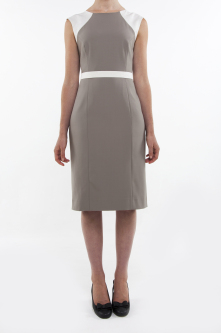
Andrea Paul left her job as a lawyer to create a clothing collection
You worked as a lawyer before, what made you quit your job to create this clothing collection?
I came to a couple of realisations while I was working as a lawyer. The first was that I didn't want to wake up one day when I was 85 years old and wonder what would have happened if I had started my own business  when I was younger. The second was that I became increasingly frustrated with the workwear options on the high street. After a lot of careful thought and discussions with my family and friends, I made the difficult decision to leave the law firm at which I was working and set up a business that creates dresses for professional women to wear to work.
when I was younger. The second was that I became increasingly frustrated with the workwear options on the high street. After a lot of careful thought and discussions with my family and friends, I made the difficult decision to leave the law firm at which I was working and set up a business that creates dresses for professional women to wear to work.
Did you have any previous design knowledge?
My university degree was in Art History, so I had a theoretical background, but I certainly did not have any formal design training. I had been sketching dress designs on and off for several years before I started my business, and that was helpful when I went to design my debut collection. I also took a couple of patternmaking classes at a fashion school in London, and I spent a week with a tailor to learn how to put a dress together; those experiences informed the designs in my debut collection.
What makes your collection so special that people should buy it over any other workwear lines?
My debut collection addresses the key frustrations I had when I shopped for workwear as a lawyer:
- it uses incredibly high quality Italian wools, silks and lace, because low quality fabrics make it difficult for highly skilled women to present themselves in a professional manner;
- it includes a range of colours, such as dark berry, brick red and cream, because I wanted to show that workwear does not have to be only black and dark grey to be work appropriate; and
- it includes dresses that have classic lines and interesting design features, such as the juxtaposition of fabrics of different textures and colours or using classic design vocabulary in an unexpected way, because I wanted my designs to show how interesting professional women are while at the same time not distract from the women themselves.
 Where do you look for inspiration of the line?
Where do you look for inspiration of the line?
My line was probably most influenced by Jackie Kennedy in her White House years. It is not that I was necessarily influenced by specific pieces she wore, it is more that I was influenced by the thinking behind what she wore. Jackie Kennedy was very aware of the power of clothing to project a certain image of her, her husband’s presidency and, by extension, the United States. Similarly, I view my collection as providing professional women with pieces that will help them to project their hard-earned skills and their interesting personalities in their workplaces.
Are there any designers who have influenced you?
To a certain extent, Givenchy, Oleg Cassini and Edith Head. I also find myself influenced quite a bit by costumes I see at the opera and the ballet.
Do you get requests from clients asking for particular designs?
My debut collection is ready-to-wear, so there is not really much scope for my clients to request designs outside of my collection. The feedback I have gotten from my clients and others who have viewed my debut collection is that they are incredibly happy to have a found a line this is so focused on quality and designs that use classic design vocabulary in an interesting way.
 How would you describe your personal style?
How would you describe your personal style?
Timeless yet modern; quality over quantity; classic yet individual.
Where do you like to shop?
The White Company for casual/vacation-wear, Theory for trousers, J Brand and Seven for All Mankind for jeans, Kate Spade and Cole Haan for shoes, the leather market in Florence for handbags and Andrea Paul for dresses!
Is there a new trend that you’re looking forward to trying this coming season?
Since my line focuses on producing very high quality dresses, they are intended to be pieces that women can wear for several years to come. As a result, I try to make sure that I steer clear of trends when I design. It doesn’t mean that my line isn’t modern, but it does mean that I am aiming for a more timeless quality than trends will allow.
How do you incorporate your personal style into your workwear clothing?
At its most fundamental level, thinking about how to incorporate your personal style into your workwear is thinking about how to incorporate who you are into how you present yourself at work. If, for example, you are someone who is ambitious and takes her work seriously but also someone who is fun-loving and independent-spirited, you’ll want to reflect all of those aspects in your workwear – that could mean high quality, beautifully cut dresses in bright colors, modern jewelry, shoes with unusual embellishments and suits with interesting design details. The answer is going to be different for everyone, but what is important is to take the time to think about how to incorporate who you are into your workwear because when you get it right, you will feel confident and that confidence will help you become better at everything you do.
To see more from Andrea's collection, visit her website www.andreapaul.com

